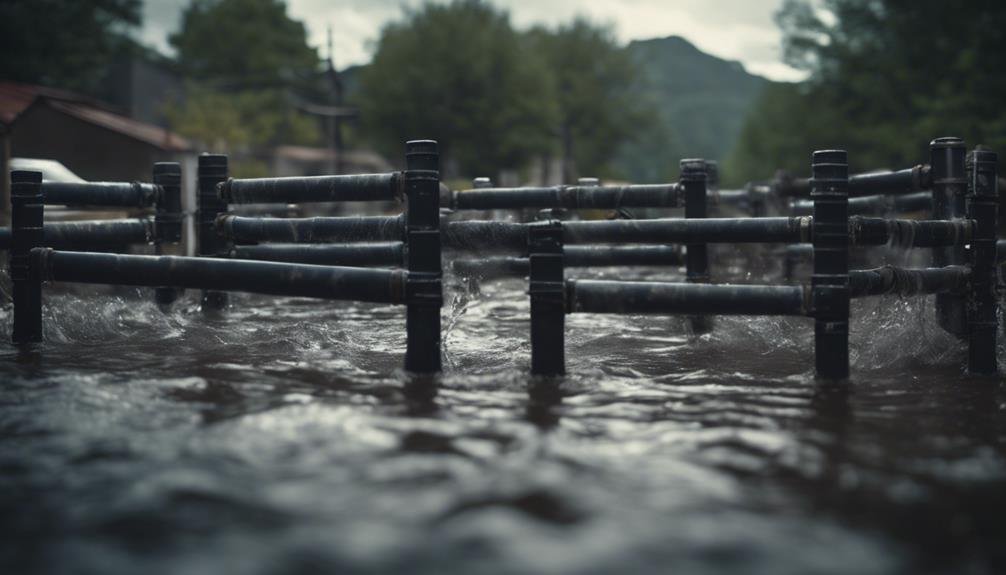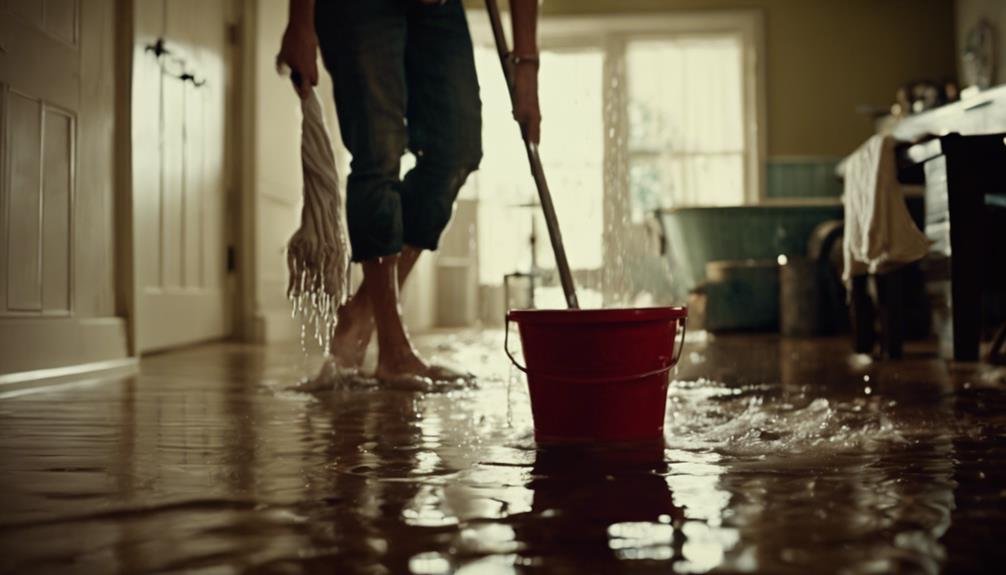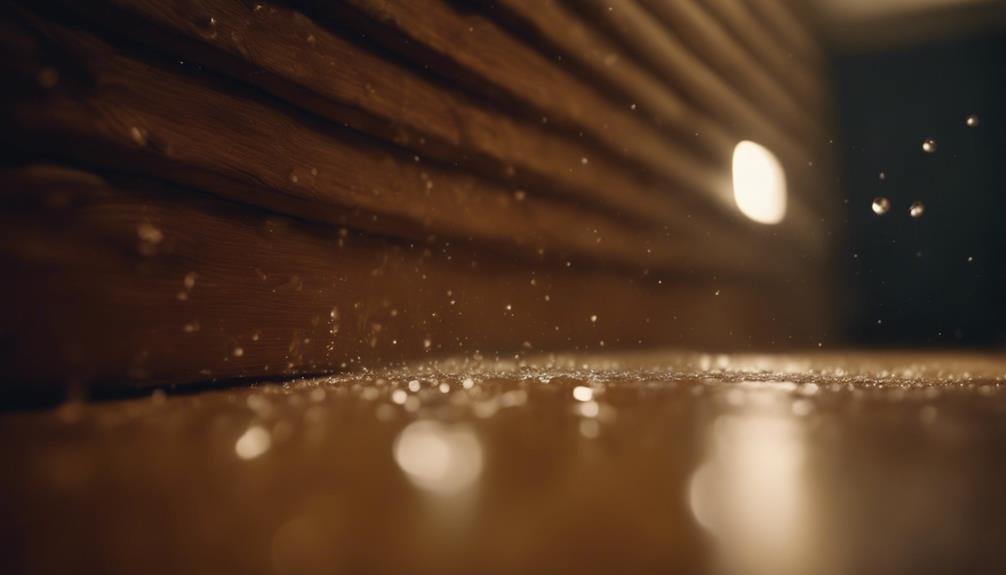When facing severe leaks, immediate action is crucial. Start by identifying the source of the leak through visual inspection for moisture or unusual sounds, or refer to building layouts for guidance.
Some of the links in this article may be affiliate links. If you make a purchase through these links, we may earn a small commission at no extra cost to you. Thank you.
Quickly stop the flow by turning off water valves and securing any loose connections. To prevent further damage, contain the leak and gather necessary supplies such as buckets and towels.
Use wet vacuums to remove any standing water and expedite the drying process by employing dehumidifiers in the affected areas. Keep a close eye on the situation for any signs of mold growth or structural damage.
If the situation worsens, seek assistance from professionals who can provide efficient repairs. By following these steps promptly, you can reduce risks and minimize potential damage.
Remember, it's always wise to consider additional preventive measures for future incidents.
Identify the Source
Before taking any action, it's essential to accurately locate the source of the leak to effectively address the issue. To start, thoroughly inspect the area for visible signs of moisture, discoloration, or water stains on walls, ceilings, or floors. Listen for any unusual sounds like dripping or running water that could help identify the leak's location.
If the source remains unclear, further investigations may be necessary. This could involve carefully removing sections of drywall or using specialized equipment such as moisture meters or infrared cameras to detect hidden moisture pockets. Consulting blueprints or layout plans to trace potential water lines or pipes may also be helpful in finding the culprit.
Once the leak's origin is pinpointed, appropriate remediation steps can be taken. Accurately determining the source is crucial to prevent additional damage and ensure a lasting solution. Thoroughly identifying the leak's location will ultimately save time and resources in the long run.
Stop the Flow
Once you've pinpointed the source of the leak, it's vital to act swiftly to halt the water flow. Depending on the seriousness and location of the leak, there are a few steps you can take.
Firstly, turn off the main water supply valve to prevent further flooding. For leaks that are easily accessible, consider tightening any loose connections or replacing worn washers and gaskets.
If the leak is coming from a pipe or fixture, shut off the shutoff valve that controls that specific line. Additionally, use buckets, towels, or other absorbent materials to contain and soak up any standing water.
If the leak persists or worsens, it's best to contact a professional plumber right away. They possess the necessary tools and expertise to locate and fix complex leaks without causing more damage.
While waiting for assistance, continue your efforts to minimize water flow and remove any standing water to prevent structural damage or mold growth. Acting quickly and methodically is crucial for reducing potential risks and avoiding expensive repairs.
Protect Surrounding Areas

Protecting the surrounding areas where a leak originates is crucial to minimize any additional damage. Once the flow has been stopped, immediate action must be taken to prevent the spread of the leak to other regions. Here are some key steps to follow:
Firstly, containment measures should be implemented to restrict the leak within a designated area. This can be achieved by using materials such as absorbents, sandbags, or setting up temporary walls to create barriers.
Secondly, it's essential to establish proper drainage systems to redirect the leaking substance away from sensitive areas. This may involve creating channels, trenches, or utilizing pumps to ensure effective drainage and prevent further leakage or flooding.
Lastly, in cases where hazardous or flammable substances are involved, ensuring adequate ventilation is crucial to prevent air contamination and potential risks of explosions. This can be achieved by utilizing fans, exhaust systems, or other ventilation methods to maintain air quality in the surrounding areas.
Gather Essential Supplies
To tackle the severe leak effectively, we must gather essential supplies. Start by getting buckets or containers to catch the water and prevent further damage. Additionally, stock up on towels and rags to quickly soak up any spills or leaks. It's also crucial to have waterproof clothing and footwear ready to keep yourself dry and secure while addressing the issue.
Having these supplies on hand will make managing the leak much easier. Imagine the relief of having the right tools available when water starts seeping through.
With buckets to contain the flow, towels to mop up excess water, and waterproof gear to stay comfortable, you'll be better equipped to handle the situation.
Buckets and Containers
In order to catch and contain leaking water, it's essential to have a good supply of buckets, pans, or large containers on hand. Here are some key points to consider:
- Opt for buckets or trash cans with handles for easy carrying and emptying.
- If needed, large pots, pans, or bowls from the kitchen can also be used.
- Storage totes or bins can serve as effective temporary leak catchers.
- To absorb excess moisture, consider lining the containers with towels or rags.
Having an adequate number of containers is crucial to capture water from multiple leak points at once. Strategically place them under drips or streams to minimize floor damage.
Be sure to empty and replace full containers regularly to prevent overflow. Acting swiftly and efficiently is important to reduce further water intrusion while addressing the root cause of the leaks.
Towels and Rags
In addition to buckets and containers, it's essential to have a good supply of absorbent towels and rags ready for severe leaks. These materials play a crucial role in containing and reducing water damage until professional assistance arrives or the leak is fixed.
It's a good idea to gather a variety of clean, dry towels, rags, and cloths. Old bath towels, hand towels, and even items like t-shirts or socks can be effective in soaking up water. Having different sizes available, from large towels for handling more water to smaller rags for tight spots, is helpful. Microfiber cloths are highly absorbent and can be particularly handy in these situations.
After containing the leak, it's important to regularly wring out and replace saturated towels and rags. By having a plentiful supply, we can stay on top of the water flow until the issue is resolved. These materials not only help contain the water but also protect surfaces like floors and furniture from damage.
With the right preparation, towels and rags can be valuable assets in minimizing the impact of severe leaks.
Waterproof Clothing/Footwear
Appropriate waterproof attire is crucial for navigating through flooded areas safely and comfortably. To ensure preparedness, it's recommended to have the following items on hand: rubber boots or waders, a waterproof jacket or poncho, waterproof pants or overalls, and waterproof gloves.
Rubber boots or waders are essential for protecting your feet from contaminated water and providing traction on slippery surfaces.
A waterproof jacket or poncho shields your upper body from moisture, while waterproof pants or overalls keep your legs dry.
Additionally, waterproof gloves are vital for handling wet objects securely without exposing your hands to potential hazards.
By wearing the right waterproof clothing and footwear, you can effectively manage severe leaks or flooding situations. This gear not only minimizes contact with possibly contaminated water but also reduces the risk of accidents like slips and falls due to wet conditions.
Being properly equipped enables you to address water-related challenges confidently and safely.
Remove Standing Water

To address a leak, start by pinpointing its source and taking steps to stem or reduce the water flow.
Then, utilize a wet vacuum to eliminate any standing water that has pooled.
Following this, it's crucial to promptly reach out to a professional plumber for a thorough assessment and necessary repairs to prevent any further damage.
Taking quick action can help mitigate the potential for extensive water damage and costly repairs down the line.
Locate Water Source
Our main priority should be locating the water source to prevent further damage. To find the leak, we can start by checking visible pipes and plumbing fixtures for any signs of moisture or dripping. It's also important to look for wet spots on walls, ceilings, or floors, as they could indicate a hidden leak.
Listening for the sound of running water can help us pinpoint where the leak is coming from. Using a moisture meter to detect dampness in dry-looking areas can also reveal hidden leaks.
If the leak isn't immediately obvious, we may need to conduct a more thorough investigation. This might involve checking hard-to-reach areas like crawl spaces or behind appliances. If necessary, we can consider hiring a professional plumber or leak detection service equipped with specialized tools to locate the source.
Once we identify the leak's location, we can take the necessary steps to stop the water flow and start repairs promptly. Acting quickly is crucial to minimize further water damage and prevent potential structural issues or mold growth. Remember, addressing the water source promptly is key to resolving the issue effectively.
Use Wet Vacuum
Once you've pinpointed the source of the leak, it's crucial to remove any standing water using a wet/dry vacuum. This step is essential to prevent further damage and simplify the cleanup process. Before starting, ensure that the vacuum is suitable for wet use and that the filters are in good shape.
Begin by clearing out any large debris or objects from the affected area. Then, proceed to vacuum up the water starting from the edges and moving towards the center. Make sure to overlap each pass to ensure thorough water removal, especially focusing on corners and hard-to-reach spots where water tends to accumulate.
In case the leak is ongoing, remember to periodically empty the vacuum's tank to avoid it getting too full. It's also important to wear proper personal protective gear like rubber boots and gloves to stay safe from slips and potential exposure to contaminated water.
Once all the standing water is gone, you can move on to drying and sanitizing the area. However, addressing the root cause of the leak should be your top priority to prevent any further water damage.
Call Plumber Immediately
After removing any standing water, it's crucial to contact a professional plumber immediately to address the root cause of the severe leak. Even if a temporary fix has been applied, it's essential to resolve the underlying issue to prevent further damage and costly repairs.
When reaching out to a plumber, be ready to provide details such as the location and extent of the leak, any visible signs of damage or moisture, when the leak started, and information about recent plumbing work.
A reputable plumber will promptly assess the situation and offer recommendations for necessary repairs or replacements. They can identify if the problem lies with faulty pipes, fixtures, or appliance connections and take the appropriate steps to fix it correctly.
It's important to avoid attempting major plumbing work yourself, as improper repairs can worsen the issue or lead to costly mistakes. Trusting the professionals to efficiently resolve severe leaks and prevent future problems is the best course of action to ensure a long-term solution.
Dry Out Affected Areas
After containing the leak, it's crucial to swiftly dry out any affected areas to prevent further damage and the growth of mold or mildew. Acting promptly is key. Start by eliminating standing water using mops, towels, or a wet/dry vacuum if possible.
If the leak has soaked drywall, carpeting, or other porous materials, consider removing those sections to facilitate proper drying.
Next, bring in industrial-grade dehumidifiers and air movers to speed up the drying process. These machines draw moisture from the air and circulate dry air throughout the affected space. Depending on the leak's severity, drying the area completely may take a few days to over a week.
Throughout the drying process, monitor progress and adjust the equipment as necessary. Once the area is entirely dry, proceed with any required repairs or replacements.
Timely addressing moisture problems is crucial to prevent lasting structural damage and ensure a healthy indoor environment.
Inspect for Damage

Thoroughly examining the affected areas is crucial to fully understanding the water damage. Once everything is dried out, we carefully check for the following signs:
- Structural problems such as sagging floors, cracked walls, or weakened foundations.
- Mold growth on surfaces, in insulation, or behind walls.
- Issues with electrical systems, wiring, or outlets that could be dangerous.
- Damage to drywall, insulation, flooring, or other porous materials.
It's important to identify all the areas impacted by the water damage. We leave no corner unchecked, removing baseboards and looking behind cabinets. Using moisture meters helps us find any hidden areas of saturation. Our experienced team can spot issues that others might overlook.
We document all our findings with detailed notes and photographs for insurance purposes. If there's significant structural damage, it's essential to have qualified professionals assess it promptly. Ignoring problems now could lead to more expensive repairs later on.
Thorough inspections allow us to fully understand the situation so we can effectively remediate and restore the property.
Call Professional Help
In case of significant water damage, it's crucial to contact certified professionals promptly. While initial efforts to minimize the damage can be made, severe leaks often require specialized expertise and equipment for effective resolution. Certified professionals are equipped with the necessary training, tools, and experience to accurately assess the extent of the damage and create a thorough remediation plan.
When choosing a professional service, it's important to research their credentials, experience, and customer reviews. Reputable companies should have relevant certifications and offer transparent pricing structures. Consider key factors such as rapid response, industry certifications, comprehensive services, and customer satisfaction when making your selection.
Rapid response is crucial as immediate action can help prevent further damage. Industry certifications ensure that the professionals adhere to industry standards in their work. Look for companies that offer comprehensive services to handle various aspects of the remediation process. Additionally, customer satisfaction, as reflected in reviews and references, can give you an idea of the quality of service you can expect.
Conclusion
When dealing with severe leaks, it's crucial to act quickly and decisively. By addressing the issue promptly, we can minimize any further damage to our property and prevent any potential health risks. Let's approach this challenge proactively, armed with the necessary knowledge to tackle it effectively.
One of the first steps to take is to locate the source of the leak. This may involve inspecting pipes, faucets, or any other potential areas where water may be escaping. Once the source is identified, we can take appropriate measures to stop the leak and prevent it from causing any more damage.
Next, it's important to assess the extent of the damage caused by the leak. This will help us determine the best course of action for repairs and restoration. In some cases, professional help may be necessary to ensure that the job is done thoroughly and efficiently.
As we work towards resolving the issue, it's essential to prioritize safety. This includes turning off the water supply to prevent any further leaks, as well as taking precautions to avoid any electrical hazards that may have been caused by the water.
By following these steps diligently and methodically, we can effectively manage severe leaks and restore normalcy to our living space.
Remember, a proactive approach is key to preventing water-related issues from persisting and causing more problems in the future.

